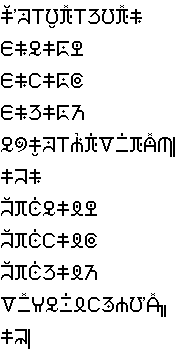Introduction

The name “sanokí” in Ebisédian means wise inscription or inscription of the wise. It was an elaborate script used, and probably invented, by the scribes in the Era of the Kingdom. The sanokí text on the right is a reproduction of a tablet preserved from that Era, showing what looks like a pedagogic story employed in the schools of the hoĸasanī.
This tablet shows the following characteristic features of sanokí:
It is written from left to right, top to bottom.
Each syllable is represented by a single letter (except word-final consonants, which appear on their own).
Vowels and vowel length are marked by various diacritics and ligatures, except when a vowel is word-initial or immediately follows another vowel, in which case it has its own glyph.
Word boundaries are marked by a dot adjacent to or within the letter (not to be confused with vowel dots above or below the letter) representing the last syllable of the word.
Sentence and paragraph boundaries are marked by using an alternate glyph for the last syllable in the sentence or paragraph. This alternate glyph is often more elaborated, and may be considered as a kind of capitalization—it is as though the Ebisédi capitalize the last letter of every sentencE, instead of the first letteR, like thiS.
Lines of writing are freely wrapped; words may be broken across lines at any point. The convention is to fit as many syllables on a line as possible, and proceed to the next line after the line is filled, regardless of whether the break is between words or in the middle of a word.
One thing not characteristic of usual sanokí writing in this tablet is the fact that it marks vowels on all words. This is probably because of its pedagogical nature: it seems to be written for young students still in their initial stages of learning to read and write, who haven't yet learned to supply the vowels on their own. The more usual convention in sanokí was to omit vowel markings except where ambiguity would arise (and even then, sometimes it was still left to context to disambiguate the vowels). An example of this can be seen in the next tablet:

This tablet contains a short inscription by one Esáni the Wise, in the characteristic dramatic style of Kingdom Era philosophical writing. As you can see, most of the vowels have been omitted. The few that are marked are for disambiguating the noun cases and distinguishing between cognate words (which often have identical consonants). Of course, non-diacritical vowels are never elided in sanokí.
This tablet is likely an amateur's copy of the original inscription—it retains the verse structure of the prose, but is awkwardly formatted. The original would have been laid out in a more symmetrical fashion.
We have also written a more in-depth analysis of Esáni's inscription.
Deciphering sanokí
We invite the reader to join us in the following tutorials to learn how to read the inscriptions on these tablets.
(Note: the following pages have a lot of inline graphics.)
The following is a translation of the first tablet:
The woman's son.
There were many children in the room. Their noise could be heard from the room. So the woman came into the room and demanded, “What is all this mess? Go outside now!”. The woman's son replied, “I have not had any children with me from the beginning; but now there are many children. So we're having fun. Why should they go outside?” The woman retorted, “Their rowdiness gives me grief and a headache. Go, go!”
History
Those readers who aren't that eager to learn the little details of sanokí may instead want to learn about its origins and history.





